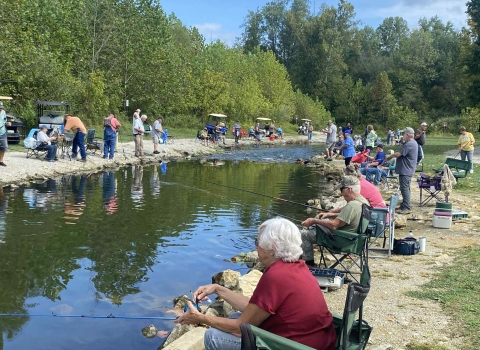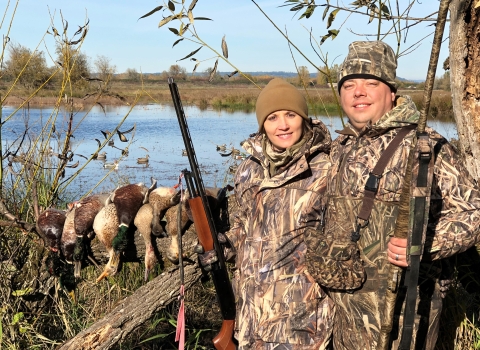Sherburne National Wildlife Refuge was established in the mid-1960s and has been welcoming avid deer and waterfowl hunters ever since. As you get ready for the deer hunting season, we could use your help to educate other hunters about the best practices and ethics that you follow when you hunt at the refuge. One of the most important best practices for a quality hunt at the refuge is the proper use of tree stands.
Sherburne is busy year-round and welcomes more than 100,000 people who love to watch wildlife, go hiking or cross-country skiing and learn about the refuge at the Oak Savanna Learning Center. With more than 230 bird species recorded on the refuge, birding is a big draw. Another big reason people visit the refuge is to hunt white-tailed deer and waterfowl. Welcoming hunters like you to the refuge each fall is important to us. We want to make sure that you have access to a quality hunt. A big part of that is knowing in advance, where, when and how you can hunt.
“Many hunters do not have their own land to hunt and the public land that Sherburne offers provides access for many people,” said Sherburne National Wildlife Refuge Manager Steve Karel.
“Permanent deer stands left overnight or throughout the season have a tendency to reserve an area and other hunters may lose out on hunting opportunities at these locations. By utilizing temporary deer stands, it provides an opportunity for all hunters to use the refuge equally,” continued Karel.
The majority of the 30,700 acre refuge is open to deer hunting, with only about 1,200 acres closed. The Oak Savanna Learning Center and other refuge buildings make up the bulk of these closed areas, as well as an area open only to hunters with mobility issues. The refuge typically averages 5,000 visits for deer hunting each year, including archery and firearms hunting. The majority of the deer hunting visits occur during the 9-day firearms deer season and can vary from year to year depending on the weather. During good weather, as many as 3,500 hunters come out to hunt. As you can imagine, it’s challenging to scout out your hunting location and get your tree stand up in that environment.
Know before you go
We follow the Minnesota State hunting seasons for archery and during gun season. You’ll need to acquire a hunt permit from the Minnesota Department of Natural Resources. No additional special refuge permits are needed at this time. Sherburne National Wildlife Refuge is in its own deer hunting designated area, Unit 224. This year the deer area management designation for Unit 224 is lottery, which means that you must apply and be entered into a drawing conducted by the state to be able to acquire a either sex permit to give the hunter an opportunity and option to hunt an antlerless deer. There will be 150 permits issued.
Under this lottery, you are allowed to harvest a buck deer with their license, but must apply for a permit to harvest an antlerless deer. Only one deer may be taken in the lottery zone.
Get familiar with Sherburne as you plan your hunt. Although the refuge does not require a special hunt permit in addition to your state license, there is a hunt brochure and map that shows hunt zones and describes refuge-specific hunting regulations. You can pickup a copy of this brochure at our headquarters and at several informational kiosks around the refuge.
While portable deer stands are allowed for these hunts, you must remove them at the end of each day, after legal shooting time which is half an hour after sunset. Permanent stands or anything that uses nails,wire, bolts, or screw-in steps are not allowed. We also allow the use of portable ground blinds.
You may enter into the refuge up to two hours before legal shooting time, but the refuge is open during daylight hours only. Although not stated, you can leave the refuge after dark, as long as you are in the act of leaving after shooting hours have ceased.
What if you see illegal activity?
If you see potentially illegal activity while you’re hunting on the refuge, safely get as much information as possible and call the Minnesota Department of Natural Resources Turn in Poachers (TIP) line at 1-800-652-9093 or key in #TIP on your cell phone.
Share a brief description of the person(s) that you witnessed, as well as the make, model, and color of their vehicle, including their license plate number, along with any other information about where you witnessed the potential illegal activity. The more information, the easier it is for officers to follow up and address the issue or violation. For emergency situation or violent crimes you should dial 911.
Ethical hunters have helped stop poaching and other illegal activity. We coordinate with conservation officers in the Fish and Wildlife Division of the Minnesota Department of Natural Resources, as well as with our federal wildlife officers and Sherburne County Sheriff's Department to follow up on your tips.
We’d like to wish you a safe and fruitful hunting season and thank you for helping to keep quality hunting opportunities available for everyone.





